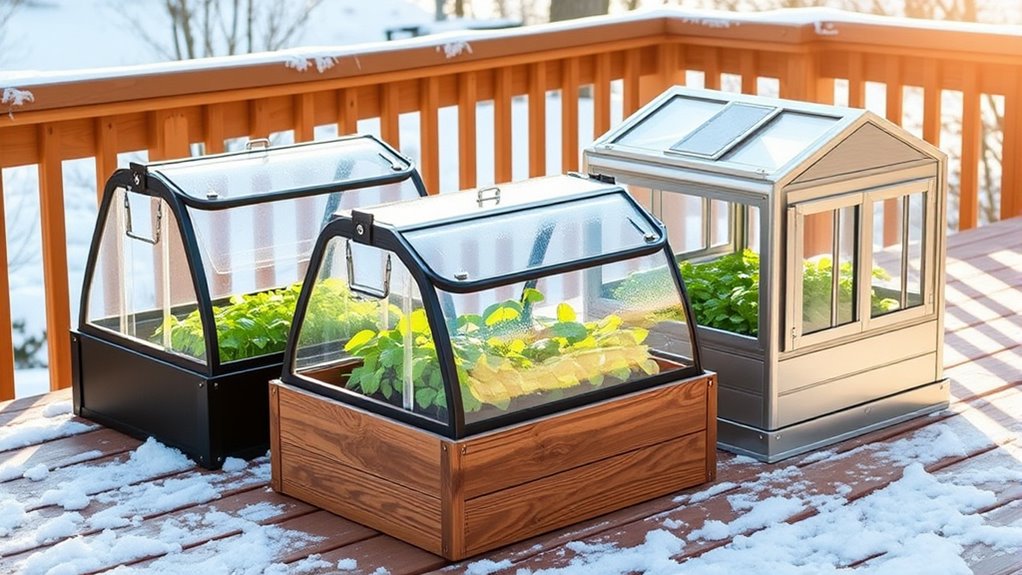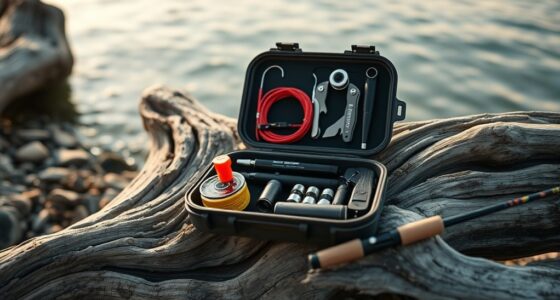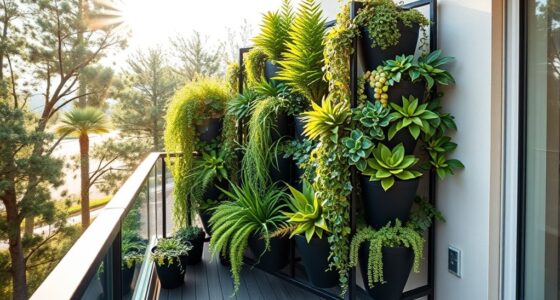If you’re looking for the best portable cold frames for easy winter gardening, I recommend the Portable Cold Frame, BioStar 1500 Premium Cold Frame, and a cedar-made model. These options are lightweight, durable, and easy to move, making winter plant protection hassle-free. They feature adjustable vents, sturdy frames, and weather-resistant panels. To find the perfect fit for your needs and garden size, keep exploring the key features that matter most.
Key Takeaways
- Look for lightweight, foldable cold frames with handles or wheels for easy portability and storage.
- Choose kits with durable, UV-resistant polycarbonate panels and weatherproof frames for long-lasting use.
- Prioritize models with adjustable vents or automatic climate control to maintain optimal winter conditions.
- Select simple, tool-free assembly options with clear instructions for quick setup and plant access.
- Opt for sizes that suit your space, from small patio units to larger garden setups, ensuring easy handling and stability.
Portable Cold Frame for Winter Gardening
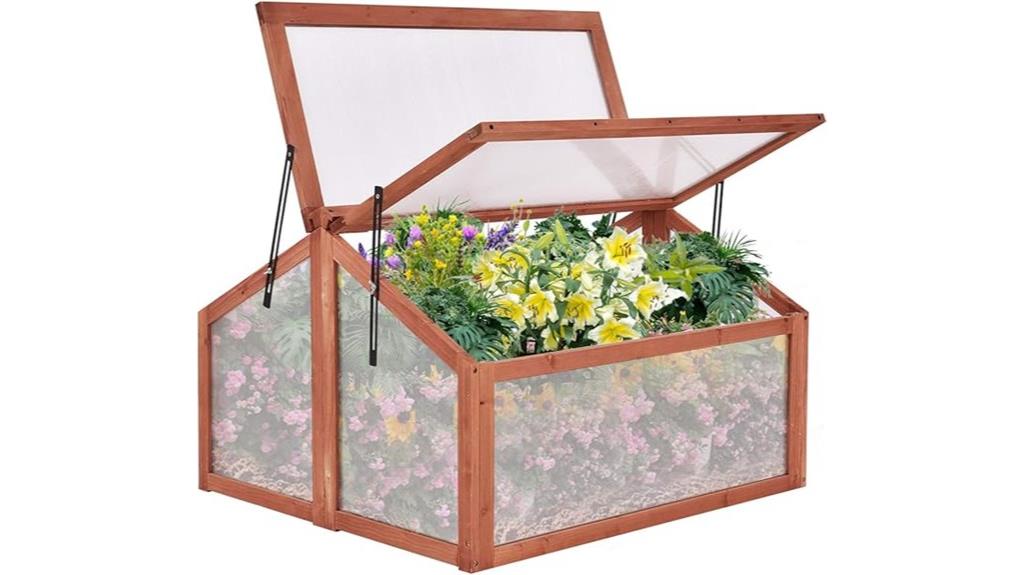
If you’re looking for an easy way to extend your winter gardening season, a portable cold frame is the perfect solution. I’ve used mine to harden seedlings, overwinter small plants, and shield my garden from harsh cold. Its lightweight design makes it simple to move around, while the sturdy construction withstands tough weather. The tilted, openable lid provides ventilation, sunlight, and easy access, ensuring plants stay healthy and grow better during winter. Made from durable FSC-certified timber and insulated polycarbonate panels, it’s built to last up to 10 years. This cold frame is a versatile, cost-effective tool for year-round gardening success.
Best For: gardeners seeking an easy, durable, and portable solution for winter seedling starting, plant protection, and overwintering small plants indoors or outdoors.
Pros:
- Easy to assemble with pre-drilled holes and detailed instructions
- Durable construction that resists cracking, mold, and harsh weather for up to 10 years
- Provides excellent insulation, ventilation, and protection from pests and elements
Cons:
- Limited size may not accommodate large plants or extensive gardens
- Slightly higher price point compared to basic cold frames or mini-greenhouses
- Requires manual relocation, which might be inconvenient for some users
BioStar 1500 Premium Cold Frame
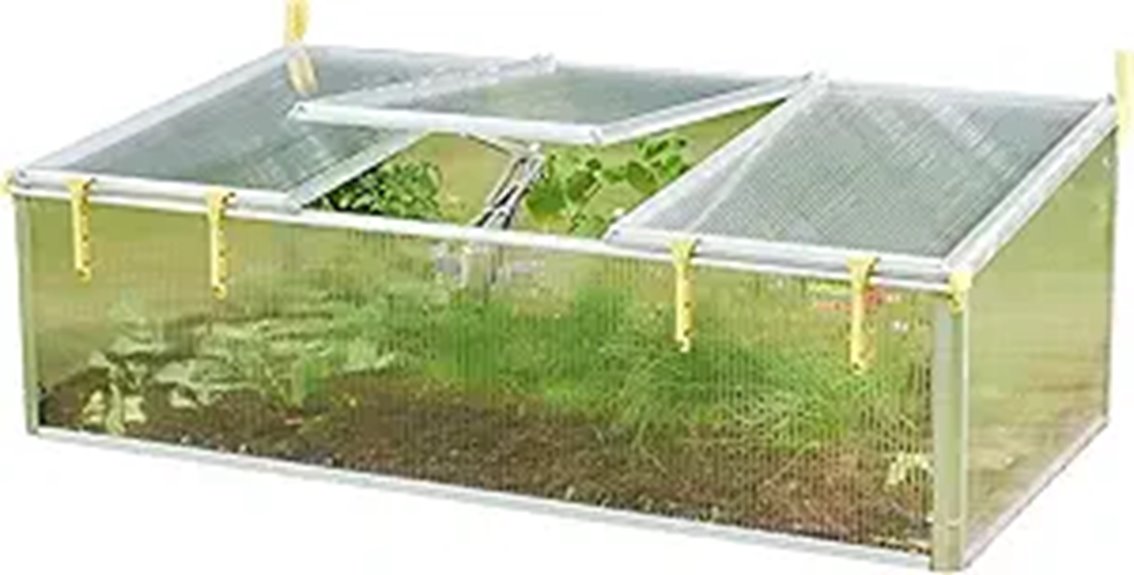
The BioStar 1500 Premium Cold Frame stands out as an excellent choice for serious gardeners who want a durable, year-round solution for extending their growing season. Its European-inspired design features UV-resistant 8mm polycarbonate double-pane panels that provide excellent insulation and light transmission, backed by a 10-year guarantee against yellowing. The sturdy aluminum frame is weather-resistant and includes corner stakes for stability. With adjustable ventilators, an automatic opener, and a no-drip coating, it offers effective climate control. Capable of withstanding harsh winter weather, the cold frame supports winter crops and early planting, making it a reliable, long-lasting addition to any garden.
Best For: serious gardeners seeking a durable, year-round cold frame to extend their growing season in cold climates.
Pros:
- Robust European-inspired design with UV-resistant double-pane polycarbonate for excellent insulation and light transmission.
- Weather-resistant aluminum frame with corner stakes ensures stability and durability in harsh winter conditions.
- Equipped with adjustable ventilators, automatic opener, and no-drip coating for effective climate control and condensation prevention.
Cons:
- Assembly requires drilling for the automatic vent opener, which may be challenging for some users.
- Slight flexing of the lightweight components can occur, especially in very strong winds or heavy snow.
- Price point around $279 may be higher compared to basic models, though it offers a 10-year warranty and long-term durability.
Cold Frame

A cold frame is an ideal choice for gardeners seeking to extend their growing season and protect delicate plants from harsh weather conditions. Made from durable Western Red Cedar, it resists rot, pests, and UV damage, while corrugated polycarbonate panels provide clear, flexible protection that lasts up to 20 years. With six adjustable vents and secure latches, you can regulate temperature easily. Measuring approximately 50 x 28 x 24 inches, it’s lightweight and simple to assemble from five pieces. Whether for early seed starting or winter hardening, this cold frame helps keep your plants safe and thriving through unpredictable weather.
Best For: gardeners looking to extend their growing season and protect delicate plants from harsh weather conditions with a durable, easy-to-assemble cold frame.
Pros:
- Made from rot, pest, and UV-resistant Western Red Cedar ensuring longevity and durability
- Features six adjustable vents and secure latches for customizable temperature control
- Corrugated polycarbonate panels are clear, flexible, and UV resistant, lasting up to 20 years
Cons:
- Assembly required, which may be time-consuming for some users
- Limited size options may not suit larger garden setups
- Does not include heating elements or additional climate control features
Factors to Consider When Choosing Portable Cold‑Frame Kits
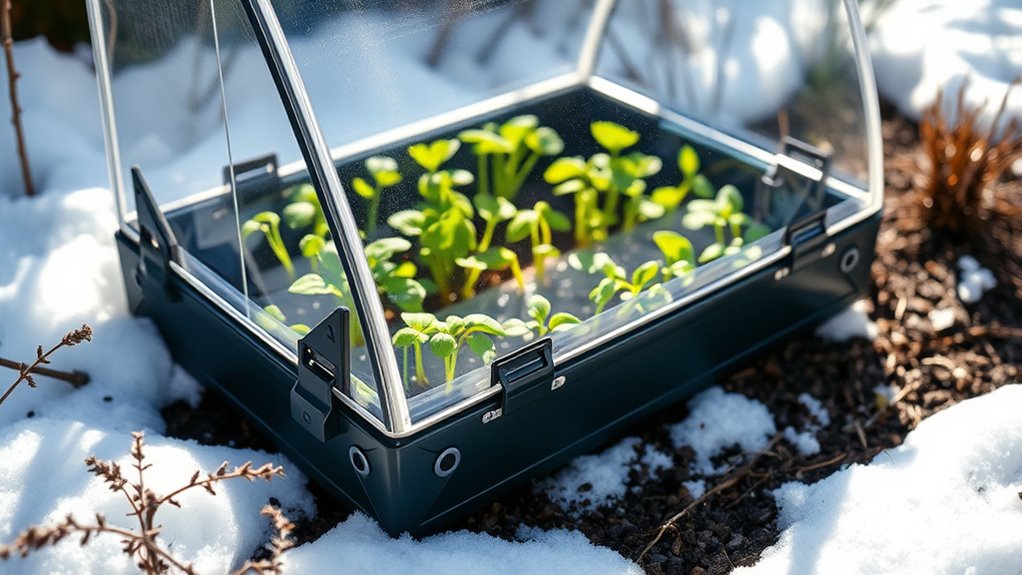
When choosing a portable cold-frame kit, I focus on factors like durability, size, and ease of setup to guarantee it meets my needs. I also consider how well it controls ventilation and insulation to protect my plants. Understanding these key points helps me select a kit that’s both effective and convenient to use.
Material Durability and Quality
Choosing a portable cold-frame kit with durable materials is essential for ensuring it withstands weather and frequent use. High-quality kits often feature FSC-certified timber, UV-resistant polycarbonate, or Western Red Cedar, which resist weathering and last longer. Strong construction elements, like double-walled panels and weatherproof aluminum or galvanized frames, help the cold frame endure harsh winter conditions without cracking or warping. UV coatings on panels, especially those guaranteeing a decade against yellowing, extend their lifespan. Using pest-proof, weatherproof screws and corner braces made from stainless steel or galvanized steel enhances the structure’s integrity and prevents corrosion. Additionally, lightweight yet sturdy materials make assembly and relocation easier, ensuring your cold frame remains functional and reliable season after season.
Size and Portability
Since the size and portability of a cold-frame kit directly impact how easily you can move and set it up, it’s crucial to take these factors carefully. Cold-frame kits come in various sizes, from small units perfect for patios to larger models for bigger gardens. Consider the weight and how easy it is to move—lightweight designs with handles or wheels make transportation simpler. Foldable or collapsible features can help with storage and transport, especially if space is limited. Make sure the dimensions match your available space and the number of plants you plan to grow, avoiding cumbersome setups. A sturdy frame made from durable materials like wood or aluminum ensures stability while remaining portable. Balancing size and ease of movement is key for a hassle-free winter gardening experience.
Ventilation and Climate Control
Ventilation and climate control are essential factors to take into account when selecting a portable cold-frame kit, as they directly influence plant health and growth. Proper airflow prevents overheating and humidity buildup, which can cause plant diseases. Adjustable vents and openable lids allow me to fine-tune airflow and temperature, ensuring ideal conditions. Some kits feature automated vent systems that open and close automatically, maintaining consistent temperatures without manual effort. Good ventilation also reduces condensation on the panels, lowering the risk of mold and mildew. A well-designed cold frame with effective climate control creates a stable environment, even when outdoor conditions fluctuate. This helps plants thrive during winter, supporting healthy growth and maximizing your gardening success.
Ease of Assembly
When selecting a portable cold-frame kit, ease of assembly is a key factor to contemplate, as it can save you time and effort during setup. Look for kits with pre-drilled screw holes and clear, straightforward instructions—they make the process much smoother. Lightweight materials and minimal parts also help reduce complexity, making assembly less overwhelming. Features like tilt-open lids and hinged doors can simplify venting and access, saving you extra steps later. Well-designed kits often include detailed manuals or visual guides, which help you follow the process step-by-step without guesswork. Additionally, check if you need specialized tools or extra hardware, as avoiding these requirements will streamline the setup even further. Overall, a simple, user-friendly design makes winter gardening hassle-free.
Insulation Effectiveness
Have you ever wondered what makes a portable cold frame truly effective at keeping plants warm? The key is insulation, which depends on the materials and design. Double-walled polycarbonate panels offer better thermal insulation than single-pane options, helping retain heat longer. Proper sealing of lids and vents prevents cold air from sneaking in and heat from escaping, maintaining a stable environment. Thicker panels and insulated frames boost heat retention, especially during cold spells. Additionally, how you position the cold frame and the angle of its lids can influence heat retention by maximizing sunlight exposure and reducing heat loss. To really gauge insulation effectiveness, I look for cold frames that maintain consistent internal temperatures during cold weather, ensuring my plants stay protected and healthy.
Weather Resistance
Choosing a portable cold frame that can withstand the elements means paying close attention to weather resistance. A sturdy, sealed frame is vital to keep out wind, rain, and snow, protecting your plants from damage. Materials like FSC-certified timber, aluminum, or UV-resistant polycarbonate panels boost durability against harsh weather. Proper ventilation, with adjustable vents and openable lids, helps regulate internal temperatures during fluctuating conditions. The construction must handle heavy snow loads, strong winds, and temperature extremes without cracking, warping, or collapsing. Sealed lids and pest-proofing features are also essential, preventing pests and moisture from entering during storms. By prioritizing these factors, you guarantee your cold frame provides reliable protection and creates a stable environment for winter gardening success.
Frequently Asked Questions
How Long Does a Portable Cold Frame Typically Last?
A portable cold frame usually lasts between 3 to 5 years, depending on how well I maintain it. I make sure to clean it regularly and store it properly during off-seasons. The materials also matter—plastic ones tend to degrade faster than wooden or metal frames. With proper care, I’ve seen mine hold up well, providing reliable protection for my plants year after year.
Can Portable Cold Frames Be Used Indoors?
Back in the day, folks used cold frames mainly outdoors, but now, I’ve found that portable cold frames can be used indoors too. They’re perfect for starting seedlings early or protecting plants during winter. Just make sure your indoor space gets enough light and ventilation. I’ve personally used one inside and loved how it extended my growing season, making winter gardening easier and more enjoyable.
Are Portable Cold Frames Suitable for All Climates?
I believe portable cold frames are generally suitable for most climates, but their effectiveness depends on specific conditions. In colder regions, I use extra insulation or heat sources to protect plants. In milder climates, they work well without much additional effort. I recommend considering your area’s temperature fluctuations and choosing a cold frame that can adapt accordingly, ensuring your plants stay protected year-round.
What Maintenance Is Required for Portable Cold Frames?
When it comes to maintaining portable cold frames, I focus on keeping them clean and inspecting for damage regularly. I clear out debris, check hinges and seals, and guarantee the glazing remains transparent for sunlight. During winter, I also secure the structure against strong winds and snow. Proper maintenance helps my cold frame stay durable and efficient, making winter gardening easier and more productive.
How Easy Is It to Relocate a Portable Cold Frame?
Relocating a portable cold frame is surprisingly easy. I find it straightforward because most kits are lightweight and designed with handles or wheels. I simply lift or roll it to my new spot, making sure the base is stable. It’s a quick process, allowing me to optimize sunlight or protect plants from harsh weather. Overall, moving my cold frame feels hassle-free and convenient for flexible winter gardening.
Conclusion
If you’re like me, embracing winter gardening with a portable cold frame makes all the difference—boosting your plant survival rates by up to 50%! With options like the Portable Cold Frame, BioStar 1500, and others, you can find the perfect fit for your space and needs. Investing in a quality cold frame isn’t just about protection; it’s about extending your growing season and enjoying fresh greens year-round. Happy gardening!

